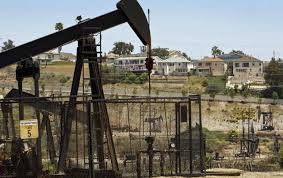The recent news that California must reduce its water use by 25% is disheartening to say the least, and countless articles and opinions have since been posited regarding who has the greater responsibility to reduce water use: farmers or the average citizen? A series of GIS maps have graphically shown a correlation between per capita wealth and water consumption (those Neoclassic fountains don’t water themselves, people!) But there is another consumer of freshwater resources that has managed to slip under the radar, mostly because it’s very profitable for the state to ignore: fracking.
Fracking, or hydraulic fracturing, has been shown to be highly effective at getting at oil and natural gas resources, trapped under hundreds of feet of rock. However, in order to get at those fossil fuels, millions of gallons of freshwater are used in the process. 70 million gallons of fresh water were used in 2014 in California fracking alone. How does that number compare to say, agricultural or residential use? It’s a drop in the bucket, relatively speaking. Almonds crops use 1.1 trillion gallons of water per year. Growth of unregulated marijuana crops in California alone have shown significant impacts on surface water flows, and are estimated to use as much as 15 billion gallons of water per year. And you can’t really eat those (but that is another blog post entirely).
If fracking is so comparatively water-wise, then why worry? It has come to light that state agencies in California have admitted to allowing fracking industries to re-inject contaminated fracking waste water back into wells that directly contaminate aquifers. The Center for Biological Diversity has posted this interactive map showing oil injection wells that are illegally contaminating the state’s aquifers; the sheer quantity of these wells is alarming. Fun chemicals found in this wastewater include such famous carcinogens as toulene, chromium-6 and benzene, among a host of others at levels as high as 2,700 times the EPA standard. Yep, 2,700 times.
So who cares? It’s such a small amount of contaminated water. Diluted, it probably, maybe, won’t hurt too many people, right? But the whole “solution to pollution is dilution” idea is less effective when aquifers are already being depleted at un-rechargeable rates (sinkholes, anyone?) And further, it is important to note that aquifers lie beneath water shed boundaries, so contamination can, and does, easily move between large geographic areas. A well full of toulene in Rancho Mirage can impact surface waters hundreds of miles away by flow through the hyporehic zone.
From an aquatic ecology standpoint, the potential for this point-source pollution to reach worrisome levels over large geographic areas in aquatic organisms is high. Entrekin et al. found that there is a serious lack of environmental impact data on the effects of fracking on surface waters (Entrekin et al. 2011) and accordingly, a lack of federal policy when it comes to protecting water resources. In a more recent paper, a similar conclusion was arrived at: Burton et al. found that despite decades of fracking, there is insufficient data on impacts to surface and ground waters (Burton et al. 2014a). Further, the confluence of construction of roads, pipelines, power grids and other associated fracking development could greatly amplify fracking’s already troublesome effects on aquatic organisms.
Fracking may not be the largest water user in this ongoing saga, but it may be one of the most detrimental on a large scale.

